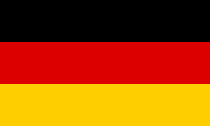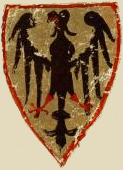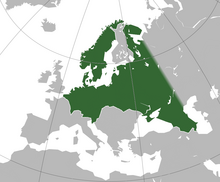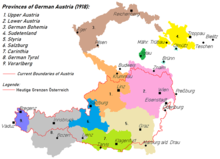German nationalism


German nationalism (
In the 19th century, Germans debated the German question over whether the German nation-state should comprise a "Lesser Germany" that excluded the Austrian Empire or a "Greater Germany" that included the Austrian Empire or its German speaking-part.[1] The faction led by Prussian Chancellor Otto von Bismarck succeeded in forging a Lesser Germany.[1]
Aggressive German nationalism and territorial expansion was a key factor leading to both World Wars. Prior to World War I, Germany had established a colonial empire in hopes of rivaling Britain and France. In the 1930s, the Nazis came to power and sought to unify all ethnic Germans under the leadership of Adolf Hitler eventually leading to the extermination of Jews, Poles, Romani, and other people deemed Untermenschen (subhumans) in the Holocaust during World War II.
After the defeat of Nazi Germany, the country was divided into East and West Germany in the opening acts of the Cold War, and each state retained a sense of German identity and held reunification as a goal, albeit in different contexts. The creation of the European Union was in part an effort to harness German identity to a European identity. West Germany underwent its economic miracle following the war, which led to the creation of a guest worker program; many of these workers ended up settling in Germany which has led to tensions around questions of national and cultural identity, especially with regard to Turks who settled in Germany.
Due to post-1945 repudiation of the Nazi regime and its atrocities, German nationalism has been generally viewed in the country as taboo
According to the Correlates of War project, patriotism in Germany before World War I ranked at or near the top, whereas today it ranks at or near the bottom of patriotism surveys.[3] However, there are also other surveys according to which modern Germany is indeed very patriotic.[4][5][6]
History
Defining a German nation
Nationalism among the Germans first developed not among the general populace but among the intellectual elites of various German states. The early German nationalist
Later German nationalists were able to define their nation more precisely, especially following the rise of Prussia and formation of the German Empire in 1871 which gave the majority of German-speakers in Europe a common political, economic and educational framework. In the late 19th century and early 20th century, some German nationalists added elements of racial ideology, ultimately culminating in the Nuremberg Laws, sections of which sought to determine by law and genetics who was to be considered German.[13]
19th century

It was not until the concept of nationalism itself was developed by German philosopher
The invasion of the
After the defeat of France in the Napoleonic Wars at the Congress of Vienna, German nationalists tried but failed to establish Germany as a nation-state, instead the German Confederation was created that was a loose collection of independent German states that lacked strong federal institutions.[17] Economic integration between the German states was achieved by the creation of the Zollverein ("Custom Union") of Germany in 1818 that existed until 1866.[17] The move to create the Zollverein was led by Prussia and the Zollverein was dominated by Prussia, causing resentment and tension between Austria and Prussia.[17]
Romantic nationalism

The Romantic movement was essential in spearheading the upsurge of
The
Görres, Arnim and Schelling began to create truly German national literature on the basis of German medieval art, religion and patriotism.[21]— N. Berkovsky, in 1935
This made scholars and critics like Fritz Strich, Thomas Mann and Victor Klemperer, who before the war were supporters of Romanticism, to reconsider their stance after the war and the Nazi experience and to adopt a more anti-Romantic position.[22]
Forgive, O
I do not possess a wise soul
Like you, and I have little patience,
So, please, come back soon, after all!
...
Restore the old
As it was, whole and immense.
Bring back all its musty junk,
And all its foolish nonsense.
The Middle Ages I’ll endure,
If you bring back the genuine item;
Just rescue us from this bastard state,
And from its farcical system...[23][24][25]
Revolutions of 1848 to German Unification of 1871


The Revolutions of 1848 led to many revolutions in various German states,[17] but widespread national feeling for a united Germandom still seemed elusive.[26] Nationalists did seize power in a number of German states, and assembled an
In the aftermath of the failed attempt to establish a liberal German nation-state, rivalry between Prussia and Austria intensified under the agenda of
By the late 1850s German nationalists emphasized military solutions. The mood fed on hatred of the French, a fear of Russia, a rejection of the 1815 Vienna settlement, and a cult of patriotic hero-warriors. War seemed a desirable means of speeding up change and progress. Nationalists thrilled to the image of an entire people in arms. Bismarck harnessed the national movement's martial pride and desire for unity and glory to weaken the political threat the liberal opposition posed to Prussia's conservatism.[28]
Prussia achieved hegemony over Germany in the "wars of unification": the Second Schleswig War (1864), the Austro-Prussian War of 1866 (which effectively excluded Austria from Germany), and the Franco-Prussian War (1870 - 1871).[1] A German nation-state was founded in 1871 called the German Empire. It embodied a "Lesser Germany", with the King of Prussia taking the throne as German Emperor (Deutscher Kaiser) and Bismarck becoming Chancellor of Germany.[1]
From 1871 to World War I, 1914–1918
Unlike the prior German nationalism of 1848 that was based upon liberal values, the German nationalism utilized by supporters of the German Empire was based upon Prussian
The
There have been rival nationalists within Germany, particularly Bavarian nationalists who claim that the terms that Bavaria entered into Germany in 1871 were controversial and have claimed the German government has long intruded into the domestic affairs of Bavaria.[34]
German nationalists in the German Empire who advocated a Greater Germany during the Bismarck era focused on overcoming dissidence by Protestant Germans to the inclusion of
Colonial empire
An important element of German nationalism, as promoted by the government and intellectual elite, was the emphasis on Germany asserting itself as a world economic and military power, aimed at competing with France and the British Empire for world power. German colonial rule in Africa (1884–1914) was an expression of nationalism and moral superiority that was justified by constructing and employing an image of the natives as "Other". This approach highlighted racist views of mankind. German colonization was characterized by the use of repressive violence in the name of ‘culture’ and ‘civilization’, concepts that had their origins in the Enlightenment. Germany's cultural-missionary project boasted that its colonial programs were humanitarian and educational endeavors. Furthermore, the widespread acceptance among intellectuals of social Darwinism justified Germany's right to acquire colonial territories as a matter of the ‘survival of the fittest’, according to historian Michael Schubert.[37][38]
Interwar period, 1918–1933

The government established after WWI, the
The government and economy of the Weimar republic was weak; Germans were dissatisfied with the government, the punitive conditions of war reparations and territorial losses of the Treaty of Versailles as well as the effects of hyperinflation.[2] Economic, social, and political cleavages fragmented Germany's society.[2] Eventually the Weimar Republic collapsed under these pressures and the political maneuverings of leading German officials and politicians.[2]
Nazi Germany, 1933–1945

The Nazi Party (NSDAP), led by Austrian-born Adolf Hitler, believed in an extreme form of German nationalism. The first point of the Nazi 25-point programme was that "We demand the unification of all Germans in the Greater Germany on the basis of the people's right to self-determination". Hitler, an Austrian-German by birth, began to develop his strong patriotic German nationalist views from a very young age. He was greatly influenced by many other Austrian pan-German nationalists in Austria-Hungary, notably Georg Ritter von Schönerer and Karl Lueger. Hitler's pan-German ideas envisioned a Greater German Reich which was to include the Austrian Germans, Sudeten Germans and other ethnic Germans. The annexing of Austria (Anschluss) and the Sudetenland (annexing of Sudetenland) completed Nazi Germany's desire to the German nationalism of the German Volksdeutsche (people/folk).
The
From 1945 to the present
After WWII, the German nation was divided into two states, West Germany and East Germany, and the former German territories east of the Oder–Neisse line were made part of Poland and Russia. The Basic Law for the Federal Republic of Germany which served as the constitution for West Germany was conceived and written as a provisional document, with the hope of reuniting East and West Germany in mind.[39] Saarland was separated by France to become its protectorate in 1946, but later joined West Germany in early 1957.
The formation of the European Economic Community, and latterly the European Union, was driven in part by forces inside and outside Germany that sought to embed Germany identity more deeply in a broader European identity, in a kind of "collaborative nationalism".[41]: 32 [42]
The reunification of Germany became a central theme in West German politics, and was made a central tenet of the East German Socialist Unity Party of Germany, albeit in the context of a Marxist vision of history in which the government of West Germany would be swept away in a proletarian revolution.[39]
The question of Germans and former German territory in Poland, as well as the status of Königsberg as part of Russia, remained hard, with people in West Germany advocating to take that territory back through the 1960s.[39] East Germany confirmed the border with Poland in 1950, while West Germany, after a period of refusal, finally accepted the border (with reservations) in 1970.[43]

The desire of the German people to be one nation again remained strong, but was accompanied by a feeling of hopelessness through the 1970s and into the 1980s;
The reunification was opposed in several quarters both inside and outside Germany, including
One of the key questions for the reunified government, was how to define a German citizen. The laws inherited from the Weimar republic that based citizenship on heredity had been taken to their extreme by the Nazis and were unpalatable and fed the ideology of German far-right nationalist parties like the
The issue of how to address its Turkish population has remained a difficult issue in Germany; many Turks have not integrated and have formed a parallel society inside Germany, and issues of using education or legal penalties to drive integration have roiled Germany from time to time, and issues of what a "German" is, accompany debates about "the Turkish question".[48][49][50][51]
Pride in being German remained a difficult issue; one of the surprises of the 2006 FIFA World Cup which was held in Germany, were widespread displays of national pride by Germans, which seemed to take even the Germans themselves by surprise and cautious delight.[52][53] In a 2011 article published by the University of Pennsylvania, it was stated that:[54]
"Patriotism in Germany has been a taboo topic since the time of Adolf Hitler, with the vast majority of Germans accepting that they cannot express any form of national pride".
Germany's role in managing the European debt crisis, especially with regard to the Greek government-debt crisis, led to criticism from some quarters, especially within Greece, of Germany wielding its power in a harsh and authoritarian way that was reminiscent of its authoritarian past and identity.[55][56][57]
Tensions over the
In the 2014 European Parliament election, the NPD won their first ever seat in the European Parliament,[61] but lost it again in the 2019 EU election.
German nationalism in Austria

After the
In addition to a form of nationalism in Austria that looked toward Germany, there have also been forms of
Symbols
-
Flag of Germany, originally designed in 1848 and used at the Frankfurt Parliament, then by the Weimar Republic, and the basis of the flags of East and West Germany from 1949 until today
-
Flag of the German Empire, originally designed in 1867 for the North German Confederation, it was adopted as the flag of Germany in 1871. This flag was used by opponents of the Weimar Republic who saw the black-red-yellow flag as a symbol of it. Recently it has been used by far-right nationalists in Germany.[citation needed]
-
Flag of Nazi Germany from 1935 to 1945. This flag was used by the Nazi Party and is now banned in many European countries, including Germany and Austria. The flag is used today by neo-Nazis. It is based on the colours of the flag of the German Empire.
Nationalist political parties
Current
In Germany
- Alternative for Germany (2013–present)
- Christian Centre — For a Germany according to GOD's commandments (1988–present)
- National Democratic Party of Germany (1964–present)
- The III. Path(2013–present)
- The Republicans (1983–present)
- German Party (1993) (1993–present)
In Austria
- Freedom Party of Austria (1956–present)
Defunct
In Germany
- All-German Bloc/League of Expellees and Deprived of Rights (1950–1961)
- Citizens in Rage (2004–June 2023)
- Free Conservative Party (1867–1918)
- Free German Workers' Party (1979–1995)
- German Party (1947–1960)
- German People's Union (1987–2011)
- National Democratic Party of Germany (1948–1990)
- National Offensive (1990–1992)
- German Fatherland Party (1917–1918)
- German National People's Party (1918–1933)
- German Reich Party (1950–1964)
- German Right Party(1946–1950)
- German Social Union (1956–1962)
- German Socialist Party (1918–1922)
- German Social Party (1921–1929)
- German Völkisch Freedom Party (1922–1924)
- German Workers' Party (1919–1920)
- Harzburg Front (1931–1933)
- National Liberal Party (1867–1918)
- National Socialist Freedom Movement (1924–1925)
- National Socialist German Workers' Party (1920–45)
- National-Social Association (1896–1903)
- Nationalist Front (1985–1992)
- Old Social Democratic Party of Germany (1926–1932)
- Pro Germany Citizens' Movement (2005–2017)
- Pro NRW (2007–2019)
- People's Socialist Movement of Germany/Labour Party (1971–1982)
- Socialist Reich Party (1949–1952)
- Völkisch-Social Bloc (1924–1924)
- Völkisch Work Community (1920s–1933)
In Austria
- Federation of Independents (1949–1955)
- Freedom Party in Carinthia (1986–2010)
- German People's Party (1896–1920)
- German-National Party (????–????)
- Greater German People's Party (1920–1934)
- Landbund (1919–1934)
- National Democratic Party(1967–1988)
In Austria-Hungary
- German National Association (1911–1917)
- German Workers' Party (1903–1918)
In Czechoslovakia
- German National Party (1919–1933)
- German National Socialist Workers' Party (1919–1933)
- Sudeten German and Carpathian German Party (1935–1938)
- Sudeten German Party (1933–1935)
In Liechtenstein
- German National Movement in Liechtenstein (1938–1945)
In Luxembourg
- Ethnic German Movement (1940–1945)
In Poland
- German People's Union in Poland(1924–????)
- Young German Party in Poland (1931–????)
In Romania
- German Party (1919–1944)
- German People's Party (1935–1938)
In Slovakia
- German Party (1938–1945)
In Switzerland
- Federal Collection (1940–1943)
- National Front (1933–1940)
- National Movement of Switzerland (1940–1940)
- People's Party of Switzerland (1951–????)
- Swiss Nationalist Party (2000–2022)
Personalities
- Adolf Hitler
- Albert Speer
- Anton Drexler
- Claus von Stauffenberg
- Erich Ludendorff
- Ernst Jünger
- Ernst Niekisch
- Gregor Strasser
- Heinrich Himmler
- Hermann Goering
- Joseph Goebbels
- Karl Dönitz
- Otto Ernst Remer
- Otto Strasser
- Otto von Bismarck
- Rudolf Hess
- Wilhelm II
- Arminius
See also
- Antisemitism in 21st century Germany
- Austrian nationalism
- Deutschtum
- Völkisch nationalism
- German diaspora
- Nordicism
- Racism in Germany
- Reichsbürgerbewegung
- Scandinavism
- Unification of Germany
- War guilt question
- Prussian nationalism
- Swiss nationalism
References
Citations
- ^ a b c d e f g Verheyen 1999, pp. 8.
- ^ a b c d Motyl 2001, pp. 190.
- ^ "Correlates of War – The Correlates of War Project". correlatesofwar.org. Retrieved 1 November 2022.
- ^ . 5 October 2016 https://web.archive.org/web/20161005112907/http://www.identity-foundation.de/images/stories/downloads/Studie_Deutsch-Sein_final_klein.pdf. Archived from the original (PDF) on 5 October 2016. Retrieved 22 March 2023.
{{cite web}}: Missing or empty|title=(help) - ^ "Stolz Deutscher zu sein". Statista (in German). Retrieved 22 March 2023.
- ^ Greenwood, Shannon (5 May 2021). "5. National pride and shame". Pew Research Center's Global Attitudes Project. Retrieved 22 March 2023.
- ^ "Nacionalismo alemán en un mapa de 1548", in Historia y Mapas
- ^ Konstantin Langmaier (2016), "Dem Land Ere und Nucz, Frid und Gemach: Das Land als Ehr-, Nutz- und Friedensgemeinschaft: Ein Beitrag zur Diskussion um den Gemeinen Nutzen.'", Vierteljahrschrift für Sozial- und Wirtschaftsgeschichte (in German), vol. 103, pp. 178–200.
- ^ Ethnologue, mutual intelligibility of German dialects / Languages of Germany.
- ^ a b Jansen, Christian (2011), "The Formation of German Nationalism, 1740–1850," in: Helmut Walser Smith (Ed.), The Oxford Handbook of Modern German History. Oxford: Oxford University Press. p. 234-259; here: p. 239-240.
- ^ The German Opposition to Hitler, Michael C. Thomsett (1997) p7.
- ^ Address to the German Nation, p52.
- ^ The German Opposition to Hitler, Michael C. Thomsett (1997)
- ^ Motyl 2001, pp. 189–190.
- ^ Smith 2010, pp. 24.
- ^ Smith 2010, pp. 41.
- ^ a b c d e f g Verheyen 1999, pp. 7.
- ^ Jusdanis 2001, pp. 82–83.
- ^ Rosenberg, Alfred (1982) [1930]. "Book I: The Conflict of Values, Chapter I. Race and Race Soul" (PDF). The Myth of the Twentieth Century: An Evaluation of the Spiritual-Intellectual Confrontations of Our Age. Translated by Bird, Vivian. Torrance, California: Noontide Press.
- ISBN 9780313295164.
- ^ Berkovsky, Naum Yakovlevich (1935). "От издательства" (PDF). Немецкая романтическая повесть. Том I. Moscow and Leningrad: Academia.
- ^ "Reactionary German Romanticism". Anasintaxi Newspaper, issue 385. 2013.
- ^ Heine, Heinrich (2007) [1844]. "Caput XVII". Germany. A Winter's Tale. Translated by Bowring, Edgar Alfred. New York: Montial.
- ^ Lukács, György (1980) [1952]. "Schelling's Later Philosophy" (PDF). The Destruction of Reason. Translated by Palmer, Peter R. London: Merlin Press.
- ^ Lukács, György (1947). "Romanticism (Die Romantik als Wendung in der deutschen Literatur)". Fortschritt und Reaktion in der deutschen Literatur. Translated by P., Anton. Berlin: Aufbau-Verlag.
- ^
ISBN 9780141917504. Retrieved 5 January 2024.
[...] in the middle of the nineteenth century, the German-speaking peoples were still ruled by a bewildering array of duchies, principalities and kingdoms. What people in central and eastern Europe meant when they described themselves as 'German' varied greatly from place to place, and many of them could scarcely understand one another because regional dialects were so strong. Politically, most 'Germans' professed loyalty to their rulers and did not see themselves as part of a single group, still less one that ought to be unified in a single state.
- ^ Verheyen 1999, pp. 7–8.
- JSTOR 20108205.
- ^ Verheyen 1999, pp. 8, 25.
- ^ Kesselman 2009, pp. 181.
- ^ Samson 2002, pp. 440.
- ^ Gerwarth 2005, pp. 20.
- ^ Wolfram Kaiser, Helmut Wohnout. Political Catholicism in Europe, 1918–45. London, England; New York City, USA: Routledge, 2004. P. 40.
- ^ James Minahan. One Europe, Many Nations: A Historical Dictionary of European National Groups. Greenwood Publishing Group, Ltd., 2000. P. 108.
- ^ Seton-Watson 1977, pp. 98.
- ^ Verheyen 1999, pp. 24.
- S2CID 143888654.
- ^ Felicity Rash, The Discourse Strategies of Imperialist Writing: The German Colonial Idea and Africa, 1848-1945 (Routledge, 2016).
- ^ doi:10.15779/Z38RS8N.
- ISBN 0465002390
- ^ ISBN 9781871516050.
- ^ Posener, Alan (20 June 2016). "German nationalism can only be contained by a united Europe". The Guardian.
- ISBN 978-0313281129.
- S2CID 42029805.
- ^ "National Democratic Party of Germany (NPD)". Encyclopædia Britannica. Retrieved 9 November 2015.
- ISBN 9781571810335.
- ^ "History of the Guest Workers". German Missions in the United States. Retrieved 14 May 2017.
- ^ "A Study says Turks are Germany's worst integrated immigrants". Retrieved 18 May 2016.
- ^ "Immigration: Survey Shows Alarming Lack of Integration in Germany". Retrieved 18 May 2016.
- ^ "The Welfare Use of Immigrants and Natives in Germany: The Case of Turkish Immigrants" (PDF). Retrieved 25 January 2017.
- ^ Prevezanos, Klaudia (30 October 2011). "Turkish guest workers transformed German society | Germany and Turkey – A difficult relationship | DW.COM | 30 October 2011". Deutsche Welle.
- ^ Bernstein, Richard (18 June 2006). "In World Cup Surprise, Flags Fly With German Pride". The New York Times.
- ^ Harding, Luke (29 June 2006). "Germany revels in explosion of national pride and silly headgear". The Guardian.
- ^ "German Patriotism: A Fresh Start". Knowledge at Wharton. Retrieved 2 April 2023.
- ^ Shuster, Simon (15 July 2015). "Germany Finds Itself Playing the Villain in Greek Drama". Time.
- ^ Wagstyl, Stefan (15 July 2015). "Merkel's tough tactics prompt criticism in Germany and abroad". Financial Times.
- ^ Cohen, Roger (13 July 2015). "The German Question Redux". The New York Times.
- ^ Taub, Amanda; Fisher, Max (18 January 2017). "Germany's Extreme Right Challenges Guilt Over Nazi Past". The New York Times.
- ^ "Understanding the 'Alternative for Germany': Origins, Aims and Consequences" (PDF). University of Denver. 16 November 2016. Retrieved 29 April 2017.
- ^ Beyer, Susanne; Fleischhauer, Jan (30 March 2016). "AfD Head Frauke Petry: 'The Immigration of Muslims Will Change Our Culture'". Der Spiegel.
- ^ "Meet the new faces ready to sweep into the European parliament". The Guardian. 26 May 2014. Retrieved 11 January 2015.
- ^ Andrew Gladding Whiteside, The Socialism of Fools: Georg Ritter von Schönerer and Austrian Pan-Germanism (U of California Press, 1975).
- ISBN 9780393046717.
- ISBN 0-415-16942-9.
- ISBN 9780415161121
- ^ Anton Pelinka, Right-Wing Populism Plus "X": The Austrian Freedom Party (FPÖ). Challenges to Consensual Politics: Democracy, Identity, and Populist Protest in the Alpine Region (Brussels: P.I.E.-Peter Lang, 2005) pp. 131–146.
- ^ Carl Waldman, Catherine Mason. Encyclopedia of European Peoples. Infobase Publishing, 2006. P. 42.
- ISBN 9781351939928.
- S2CID 155780619.
- S2CID 143887139.
Works cited
- Gerwarth, Robert (2005). The Bismarck myth: Weimar Germany and the legacy of the Iron Chancellor. Oxford, England, UK: Oxford University Press. ISBN 0-19-928184-X.
- Jusdanis, Gregory (2001). The Necessary Nation. Princeton UP. ISBN 0-691-08902-7.
- Kesselman, Mark (2009). European Politics in Transition. Boston: Houghton Mifflin Company. ISBN 978-0-618-87078-3.
- ISBN 0-12-227230-7.
- Samson, James (2002). The Cambridge History of Nineteenth-Century Music. Cambridge UP. ISBN 0-521-59017-5.
- ISBN 0-416-76810-5.
- ISBN 978-0-19-289260-7.
- Verheyen, Dirk (1999). The German question: A Cultural, Historical, and Geopolitical Exploration. Westview Press. ISBN 0-8133-6878-2.
Further reading
- Hagemann, Karen (1997). "Of 'manly valor' and 'German Honor': nation, war, and masculinity in the age of the Prussian uprising against Napoleon". Central European History. 30 (2): 187–220. S2CID 145528544.
- Pinson, K.S. (1934). Pietism as a Factor in the Rise of German Nationalism. Columbia UO.
- Smith, Helmut Walser (2014). German nationalism and religious conflict: culture, ideology, politics, 1870–1914. Princeton University Press.
- Helmut Walser Smith. 2020. Germany: A Nation in Its Time, Before, During, and After Nationalism, 1500–2000. W.W. Norton.
- Schulze, Hagen (1991). The Course of German Nationalism: From Frederick the Great to Bismarck 1763–1867. Cambridge University Press.


![Flag of the German Empire, originally designed in 1867 for the North German Confederation, it was adopted as the flag of Germany in 1871. This flag was used by opponents of the Weimar Republic who saw the black-red-yellow flag as a symbol of it. Recently it has been used by far-right nationalists in Germany.[citation needed]](http://upload.wikimedia.org/wikipedia/commons/thumb/1/1f/Flag_of_Germany_%281867%E2%80%931918%29.svg/120px-Flag_of_Germany_%281867%E2%80%931918%29.svg.png)
